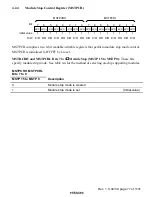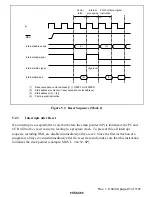
Rev. 1.0, 02/00, page 90 of 1141
5.2
Reset
5.2.1
Overview
A reset has the highest exception priority. When the
5(6
pin goes low, all processing halts and
the LSI enters the reset state. A reset initializes the internal state of the CPU and the registers of
on-chip supporting modules. Immediately after a reset, interrupt control mode 0 is set.
Reset exception handling begins when the
5(6
pin changes from low to high.
The LSIs can also be reset by overflow of the watchdog timer. For details, see section 17,
Watchdog Timer.
5.2.2
Reset Sequence
The LSI enters the reset state when the
5(6
pin goes low.
To ensure that the chip is reset, hold the
5(6
pin low during the oscillation stabilizing time of the
clock oscillator when powering on. To reset the chip during operation, hold the
5(6
pin low for
at least 20 states. For pin states in a reset, see Appendix D, Port States in the Different Processing
States.
When the
5(6
pin goes high after being held low for the necessary time, the chip starts reset
exception handling as follows:
1. The internal state of the CPU and the registers of the on-chip supporting modules are
initialized, and the I bit is set to 1 in CCR.
2. The reset exception vector address is read and transferred to the PC, and program execution
starts from the address indicated by the PC.
Figure 5.2 shows examples of the reset sequence.
















































